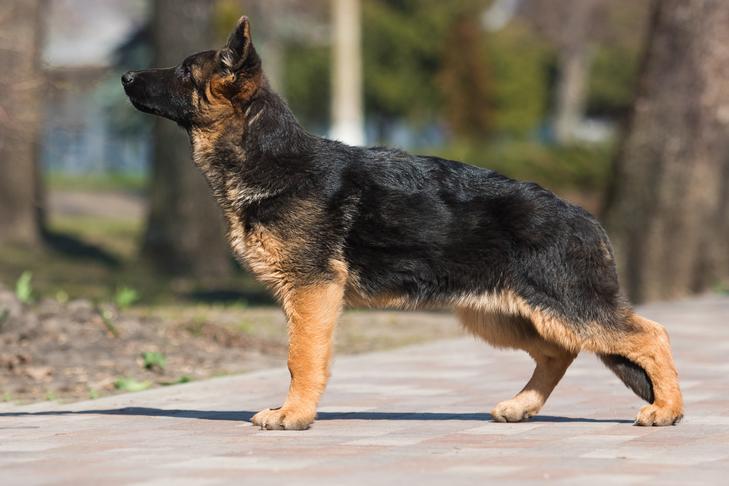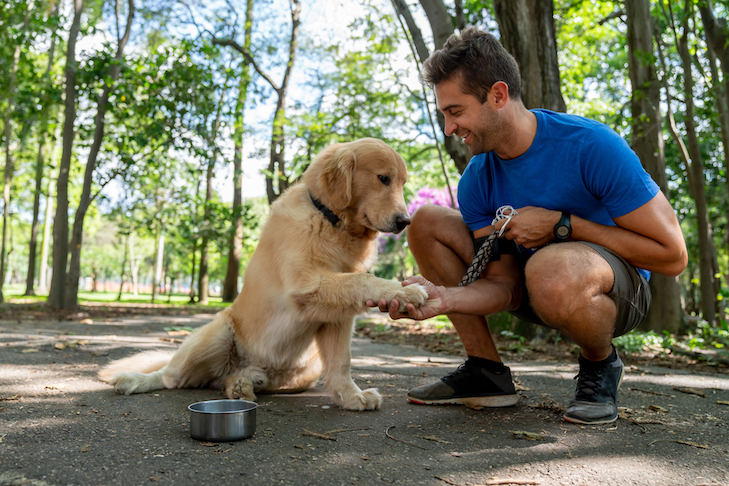AKC is a participant in affiliate advertising programs designed to provide a means for sites to earn advertising fees by advertising and linking to akc.org. If you purchase a product through this article, we may receive a portion of the sale.
There are many tools that can help you with dog training such as clickers, treats, and a positive attitude. Dog whistles may not be as commonly used, but they’re another tool to help you communicate with your dog. They aren’t magic, but if you train your dog to associate a whistle with rewards, you can incorporate one into your training for many different behaviors.
How Do Dog Whistles Work?
Dog whistles are simply whistles that produce a high-pitched sound. These higher frequencies are well suited to dog ears because dogs can hear sounds as high-pitched as 45,000 Hz or higher, whereas adult humans can only hear sounds as high-pitched as 20,000 Hz. That means there are many sounds your dog can hear that you can’t, and the shriek of a dog whistle will be clearly audible to your dog even at a distance.
But how do these special whistles work? First, there are two myths to bust. One is that the high sound can stop a dog from barking. Although the first few blows may distract your dog into silence, they will likely acclimatize to the noise and bark right through it. The second myth is that dog whistles make your dog come when called. However, there is nothing about the whistle itself that tells your dog what to do. Whistles are just another cue like a word or hand signal. You need to train your dog to respond accordingly.

Rachel Lane, dog trainer, certified behavior consultant, and owner of Leash & Learn, uses dog whistles as a cue for the recall behavior. “I incorporate whistles into my training program because of the many distinct advantages that they provide. Most importantly, it is an effective tool for communication and makes it easier for handlers to teach their dog to come to them reliably, the first time they hear the whistle, and every time they hear the whistle.”
Are There Different Types of Dog Whistles?
Dog whistles come in a range of frequencies and types, and Lane advises her clients to choose whichever one they like. It’s worth experimenting to find the version your dog responds to best and what you feel most comfortable using. In Psychology Today, Dr. Stanley Coren said a small dog might respond well to a higher pitch whereas a larger dog might not. He also said a dog who seems to have lost their sense of hearing may respond to certain high-pitched sounds if they haven’t lost their hearing in that higher range, so whistles are worth a try even with deaf dogs.
The typical dog whistle makes a single pitch when blown. But there are also two-tone dog whistles that produce two different pitches you can choose between. This can be handy if you want to work with two dogs as you can assign each dog a different sound. Alternatively, you can train each tone as a cue for a different behavior. There are also dog whistles that allow for a whole range of sounds. Also known as a shepherd’s lip whistle, these require more practice to get the tone where you want it, but are popular in the herding world. There are also dog whistles with peas (a small ball that vibrates inside the whistle when you blow) that are better for cold conditions as the whistle won’t freeze. You can even get a dog whistle/clicker combination tool.
Finally, you need to decide if you want to hear the whistle or not. Some whistles are within the audible range for humans and others are silent. However, a better term is ultrasonic as these silent dog whistles still make a sound. It’s just one too high for human hearing. Ultrasonic whistles won’t bother your neighbors or housemates, but as you can’t hear it, you might not feel as comfortable using it for multiple cues such as three toots for a recall and a long toot for a sit.

When Can You Use a Dog Whistle?
A dog whistle makes a great recall cue. Lane also believes the whistle is great for teaching a stay-where-you-are behavior. This can be helpful if you want to work with your dog at a distance, such as in many dog sports or when hunting. Lane says, “The dog can be 100 feet away, and when you use your whistle-to-stay cue, the dog remains motionless. Unlike a traditional stay, you would not have to call the dog, sit the dog, and then cue the stay.”
A dog whistle is simply a cue like any other, which means if you can teach your dog the behavior, you can add the whistle as a cue to perform it. Just as you might ask for down with the word “down” or a hand gesture, you can teach your dog that a certain pattern of whistle toots means the same thing. Lane says, “Different patterns of whistle sounds and durations can cue different behaviors. Similar to how you may see a sea lion or dolphin trainer use one at demonstration events.”
What Are the Advantages to Using a Dog Whistle?
One benefit of using dog whistles is their high, piercing tone that carries well over long distances and cuts through background noise. Dogs have more sensitive hearing at these high pitches than humans so can easily hear the sound. That makes whistles great for long distance communication.
Lane also points out that whistles are predictable as they’re the same every time you blow them. This makes them great for dogs with multiple handlers as the cue is consistent between them. And unlike your voice, whistles don’t carry emotions. “It doesn’t matter if the handler is excited, scared, worried, frustrated, or angry,” she says, “the whistle will sound (about) the exact same no matter what the handler is feeling at that time.”
Are There Any Pitfalls With Using a Dog Whistle?

However, there are some disadvantages. With the audible variety, Lane has had some clients express discomfort at how loud the whistle sounds to those around them. But she feels your dog’s safety is worth the looks you may or may not receive from onlookers. “For what it’s worth, we often are worried about the opinion of bystanders because we are trying to avoid criticism, judgment, or embarrassment. But we have no way of knowing what the person is thinking. Maybe they are envious of your dog’s fantastic whistle recall!”
You might also worry about your dog responding to somebody else’s whistle. But if you choose a specific tone or pattern for your cues, you’re less likely to encounter overlap with other dog owners. And of course, be aware that the sound of the whistle is louder to your dog than it is to you. You don’t need to blow the whistle at full strength for your dog to hear it. And never blow the whistle directly into your dog’s ears as that will be painful for your pet.
Whistles may not be the best choice for all training. They’re best used in sports used in sports that require communication over long distances, like herding and hunting. Close range may not be the best place to train with whistles for all dog owners.
How Do You Train Your Dog to Respond to a Dog Whistle?
Before training any cues with a whistle, you want to teach your dog that it’s worth paying attention to that sound. Lane recommends going to a quiet area of your home with the whistle and treats your dog loves. While your dog is looking at you, blow the whistle then feed your dog five treats, one at a time. Then wait several minutes before the next whistle blow. Make every toot on the whistle a big party, so your dog comes to associate it with wonderful things. Now you’re ready to use it as a cue. Simply pick the pattern you want to use.
If your dog already reliably knows a verbal cue or hand signal for a behavior, blow the whistle right before saying the word or making the gesture. In time, you can phase out the word/signal and use the whistle alone. However, if your dog doesn’t already know the behavior, either capture, shape, or lure the behavior until you can predict your dog’s performance. Then blow the whistle right before your dog does the behavior and reward them right after. Eventually, they will realize the whistle is an opportunity to earn a reward if they do that behavior. Then you can toot your own horn for having a dog that behaves with whistle cues.

